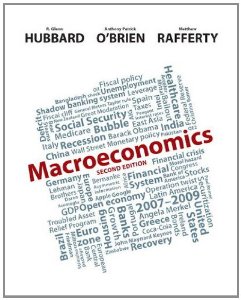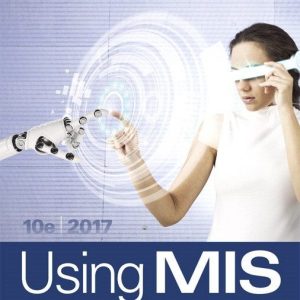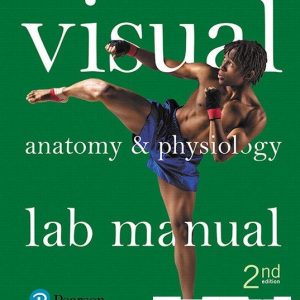This is completed downloadable of Test Bank for Macroeconomics, 2nd Edition : Hubbard

Product Details:
- ISBN-10 : 0132992795
- ISBN-13 : 978-0132992794
- Author:
Hubbard, O’Brien, and Rafferty realize that most students enrolled in today’s intermediate macroeconomics courses are either undergraduate or masters students who are likely to become entrepreneurs, managers, bankers, stock brokers, accountants, lawyers, or government officials. Very few students will pursue a Ph.D. in economics. Given this student profile, Hubbard, O’Brien, and Rafferty’s text presents Intermediate Macroeconomics in the context of contemporary events, policy, and business with an integrated explanation of today’s financial crisis. Student and instructor feedback tells us that Hubbard, O’Brien, and Rafferty helps make the link between theory and real-world easier for students!
Table of Content:
- Chapter 1 The Long and Short of Macroeconomics
- Learning Objectives
- When You Enter the Job Market can Matter a Lot
- What Macroeconomics Is About
- Macroeconomics in the Short Run and in the Long Run
- Long-Run Growth in the United States
- Some Countries Have Not Experienced Significant Long-Run Growth
- Aging Populations Pose a Challenge to Governments Around the World
- Unemployment in the United States
- Unemployment Rates Differ Across Developed Countries
- Inflation Rates Fluctuate Over Time and Across Countries
- Economic Policy Can Help Stabilize the Economy
- International Factors Have Become Increasingly Important in Explaining Macroeconomic Events
- How Economists Think About Macroeconomics
- What Is the Best Way to Analyze Macroeconomic Issues?
- Macroeconomic Models
- Solving the Problem
- Assumptions, Endogenous Variables, and Exogenous Variables in Economic Models
- Forming and Testing Hypotheses in Economic Models
- Key Issues and Questions of Macroeconomics
- Key Terms and Problems
- Key Terms
- 1.1 What Macroeconomics Is About Become familiar with the focus of macroeconomics.
- Review Questions
- Problems and Applications
- 1.2 How Economists Think About Macroeconomics Explain how economists approach macroeconomic questions.
- Review Questions
- Problems and Applications
- Data Exercises
- Chapter 2 Measuring the Macroeconomy
- Learning Objectives
- How Do We Know When We Are in a Recession?
- GDP: Measuring Total Production and Total Income
- How the Government Calculates GDP
- Production and Income
- The Circular Flow of Income
- An Example of Measuring GDP
- National Income Identities and the Components of GDP
- The Relationship Between GDP and GNP
- GDP Versus GDI
- GDP and National Income
- Real GDP, Nominal GDP, and the GDP Deflator
- Solving the Problem
- Price Indexes and the GDP Deflator
- Solving the Problem
- The Chain-Weighted Measure of Real GDP
- Comparing GDP Across Countries
- Inflation Rates and Interest Rates
- How Accurate Is the CPI?
- The Way the Federal Reserve Measures Inflation
- Interest Rates
- Measuring Employment and Unemployment
- Answering the Key Question
- Key Terms and Problems
- Key Terms
- 2.1 GDP: Measuring Total Production and Total Income Explain how economists use gross domestic product (GDP) to measure total production and total income.
- Review Questions
- Problems and Applications
- 2.2 Real GDP, Nominal GDP, and the GDP Deflator Discuss the difference between real GDP and nominal GDP.
- Review Question
- Problems and Applications
- 2.3 Inflation Rates and Interest Rates Explain how the inflation rate is measured and distinguish between real and nominal interest rates.
- Review Questions
- Problems and Applications
- 2.4Measuring Employment and Unemployment Understand how to calculate the unemployment rate.
- Review Questions
- Problems and Applications
- Data Exercises
- Chapter 3 The U.S. Financial System
- Learning Objectives
- The Wonderful World of Credit
- An Overview of the Financial System
- Financial Markets and Financial Intermediaries
- Banking and Securitization
- Asymmetric Information and Principal–Agent Problems in Financial Markets
- Financial Crises, Government Policy, and the Financial System
- Financial Intermediaries and Leverage
- Bank Panics
- Government Policies to Deal with Bank Panics
- The Financial Crisis of 2007–2009
- The Mortgage Market and the Subprime Lending Disaster
- Runs on the Shadow Banking System
- Government Policies to Deal with the Financial Crisis of 2007–2009
- The Money Market and the Risk Structure and Term Structure of Interest Rates
- The Demand and Supply of Money
- Shifts in the Money Demand Curve
- Equilibrium in the Money Market
- Calculating Bond Interest Rates and the Concept of Present Value
- Present Value and the Prices of Stocks and Bonds
- Solving the Problem
- The Economy’s Many Interest Rates
- Answering the Key Question
- Key Terms and Problems
- Key Terms
- 3.1 An Overview of the Financial System Describe the financial system and explain the role it plays in the economy.
- Review Questions
- Problems and Applications
- 3.2 Financial Crises, Government Policy, and the Financial System Understand the role of the central bank in stabilizing the financial system.
- Review Questions
- Problems and Applications
- 3.3 The Money Market and the Risk Structure and Term Structure of Interest Rates Explain how interest rates are determined in the money market and understand the risk structure and the term structure of interest rates.
- Review Questions
- Problems and Applications
- Data Exercises
- Chapter 4 The Global Financial System
- Learning Objectives
- Did U.S. Monetary Policy Slow Brazil’s Growth?
- The Balance of Payments
- The Current Account
- The Financial Account
- The Capital Account
- Exchange Rates and Exchange Rate Policy
- Nominal Exchange Rates
- Real Exchange Rates
- The Foreign-Exchange Market
- Exchange Rate Policy
- Policy Choices and the Current Exchange Rate Systems
- What Factors Determine Exchange Rates?
- Purchasing Power Parity
- Why Purchasing Power Parity Doesn’t Hold Exactly
- The Interest Parity Condition
- Solving the Problem
- The Loanable Funds Model and the International Capital Market
- Saving and Supply in the Loanable Funds Market
- Investment and the Demand for Loanable Funds
- Explaining Movements in Saving, Investment, and the Real Interest Rate
- The International Capital Market and the Interest Rate
- Small Open Economy
- Large Open Economy
- Answering the Key Question
- Key Terms and Problems
- Key Terms
- 4.1 The Balance of Payments Explain how to calculate the balance of payments.
- Review Questions
- Problems and Applications
- 4.2 Exchange Rates and Exchange Rate Policy Understand the advantages and disadvantages of different exchange rate policies.
- Review Questions
- Problems and Applications
- 4.3 What Factors Determine Exchange Rates? Discuss what factors determine exchange rates.
- Review Questions
- Problems and Applications
- 4.4 The Loanable Funds Model and the International Capital Market Use the loanable funds model to analyze the international capital market.
- Review Questions
- Problems and Applications
- Data Exercises
- Chapter 5 The Standard of Living over Time and Across Countries
- Learning Objectives
- Who Is Number One?
- The Aggregate Production Function
- The Cobb–Douglas Production Function
- The Demand for Labor and the Demand for Capital
- Changes in Capital, Labor, and Total Factor Productivity
- A Model of Real GDP in the Long Run
- The Markets for Capital and Labor
- Combining the Factor Markets with the Aggregate Production Function
- The Division of Total Income
- Solving the Problem
- What Determines Levels of Real GDP Across Countries?
- Why Real GDP per Worker Varies Among Countries
- The per Worker Production Function
- What Determines Labor Productivity?
- What Determines Real GDP per Capita?
- Total Factor Productivity and Labor Productivity
- What Explains Total Factor Productivity?
- Answering the Key Question
- Key Terms and Problems
- Key Terms
- 5.1 The Aggregate Production Function Describe the aggregate production function.
- Review Questions
- Problems and Applications
- 5.2 A Model of Real GDP in the Long Run Explain how real GDP is determined in the long run.
- Review Questions
- Problems and Applications
- 5.3 Why Real GDP per Worker Varies Among Countries Understand why the standard of living varies across countries.
- Review Questions
- Problems and Applications
- 5.4 Total Factor Productivity and Labor Productivity Understand why labor productivity varies across countries.
- Review Questions
- Problems and Applications
- Data Exercises
- Chapter 6 Long-Run Economic Growth
- Learning Objectives
- The Surprising Economic Rise of India
- The Solow Growth Model
- Capital Accumulation
- The Steady State
- Transition to the Steady State
- Saving Rates and Growth Rates
- Labor Force Growth and the Solow Growth Model
- Labor Force Growth and the Steady State
- The Effect of an Increase in the Labor Force Growth Rate
- Solving the Problem
- Technological Change and the Solow Growth Model
- Technological Change
- Technological Change and the Steady State
- Steady-State Growth Rates
- Balanced Growth, Convergence, and Long-Run Equilibrium
- Convergence to the Balanced Growth Path
- Do All Countries Converge to the Same Steady State?
- Endogenous Growth Theory
- AK Growth Models: Reconsidering Diminishing Returns
- Two-Sector Growth Model: The Production of Knowledge
- Policies to Promote Economic Growth
- Answering the Key Question
- Key Terms and Problems
- Key Terms
- 6.1 The Solow Growth Model Understand the effect of capital accumulation on labor productivity.
- Review Questions
- Problems and Applications
- 6.2 Labor Force Growth and the Solow Growth Model Understand the effect of labor force growth on labor productivity.
- Review Questions
- Problems and Applications
- 6.3 Technological Change and the Solow Growth Model Understand the effect of technological change on labor productivity and the standard of living.
- Review Questions
- Problems and Applications
- 6.4 The Balanced Growth Path, Convergence, and Long-Run Equilibrium Explain balanced growth, convergence, and long-run equilibrium.
- Review Questions
- Problems and Applications
- 6.5 Endogenous Growth Theory Explain the determinants of technological change using the endogenous growth model.
- Review Questions
- Problems and Applications
- Data Exercises
- Chapter 7 Money and Inflation
- Learning Objectives
- What Can You Buy With $100 Trillion?
- What Is Money, and Why Do We Need It?
- The Functions of Money
- Commodity Money Versus Fiat Money
- How Is Money Measured?
- Which Measure of the Money Supply Should We Use?
- The Federal Reserve and the Money Supply
- How the Fed Changes the Monetary Base
- The Process of Money Creation
- The Quantity Theory of Money and Inflation
- The Quantity Theory of Money
- The Quantity Theory Explanation of Inflation
- Solving the Problem
- Can the Quantity Theory Accurately Predict the Inflation Rate?
- The Relationships Among the Growth Rate of Money, Inflation, and the Nominal Interest Rate
- Real Interest Rates and Expected Real Interest Rates
- The Fisher Effect
- Money Growth and the Nominal Interest Rate
- The Costs of Inflation
- Costs of Expected Inflation
- How Large Are the Costs of Expected Inflation?
- Costs of Unexpected Inflation
- Inflation Uncertainty
- Benefits of Inflation
- Hyperinflation and Its Causes
- Causes of Hyperinflation
- German Hyperinflation After World War I
- Answering the Key Question
- Key Terms and Problems
- Key Terms
- 7.1 What Is Money, and Why Do We Need It? Define money and explain its functions.
- Review Questions
- Problems and Applications
- 7.2 The Federal Reserve and the Money Supply Explain how the Federal Reserve changes the money supply.
- Review Questions
- Problems and Applications
- 7.3 The Quantity Theory of Money and Inflation Describe the quantity theory of money and use it to explain the connection between changes in the money supply and the inflation rate.
- Review Questions
- Problems and Applications
- 7.4 The Relationships Among the Growth Rate of Money, Inflation, and the Nominal Interest Rate Discuss the relationships among the growth rate of money, inflation, and nominal interest rates.
- Review Questions
- Problems and Applications
- 7.5 The Costs of Inflation Explain the costs of a monetary policy that allows inflation to be greater than zero.
- Review Questions
- Problems and Applications
- 7.6 Hyperinflation and Its Causes Explain the causes of hyperinflation.
- Review Questions
- Problems and Applications
- Data Exercises
- Open Market Operations
- The Simple Deposit Multiplier
- A More Realistic Money Multiplier
- Chapter 8 The Labor Market
- Learning Objectives
- If Firms Have Trouble Finding Workers, Why Is the Unemployment Rate so High?
- The Labor Market
- Nominal and Real Wages
- The Demand for Labor Services
- Shifting the Demand Curve
- The Supply of Labor Services
- Factors That Shift the Labor Supply Curve
- Equilibrium in the Labor Market
- The Effect of Technological Change
- Solving the Problem
- Categories of Unemployment
- Frictional Unemployment and Job Search
- Structural Unemployment
- Cyclical Unemployment
- Full Employment
- Unemployment Around the World
- Duration of Unemployment Around the World
- The Natural Rate of Unemployment
- A Simple Model of the Natural Rate of Unemployment
- Solving the Problem
- What Determines the Natural Rate of Unemployment?
- Why Does Unemployment Exist?
- Equilibrium Real Wages and Unemployment
- Efficiency Wages
- Labor Unions Around the World
- Minimum Wage Laws
- Answering the Key Question
- Key Terms and Problems
- Key Terms
- 8.1 The Labor Market Use the model of demand and supply for labor to explain how wages and employment are determined.
- Review Questions
- Problems and Applications
- 8.2 Categories of Unemployment Define unemployment and explain the three categories of unemployment.
- Review Questions
- Problems and Applications
- 8.3 The Natural Rate of Unemployment Explain the natural rate of unemployment.
- Review Questions
- Problems and Applications
- 8.4 Why Does Unemployment Exist? Explain how government policies affect the unemployment rate.
- Review Questions
- Problems and Applications
- Data Exercises
- Chapter 9 Business Cycles
- Learning Objectives
- Is the Housing Cycle the Business Cycle?
- The Short Run and the Long Run in Macroeconomics
- The Keynesian and Classical Approaches
- Macroeconomic Shocks and Price Flexibility
- Why Are Prices Sticky in the Short Run?
- What Happens During a Business Cycle?
- The Changing Severity of the U.S. Business Cycle
- How Do We Know the Economy Is in an Expansion or a Recession?
- Measuring Business Cycles
- Solving the Problem
- Costs of the Business Cycle
- Movements of Economic Variables During the Business Cycle
- The Global Business Cycle
- Shocks and Business Cycles
- Multiplier Effects
- An Example of a Shock with Multiplier Effects: The Bursting of the Housing Bubble
- A Simple Model of the Business Cycle: Aggregate Demand and Aggregate Supply
- Aggregate Demand and Aggregate Supply: An Introduction
- Aggregate Supply Shocks and the Business Cycle
- Aggregate Demand Shocks and the Business Cycle
- Should Policy Try to Offset Shocks?
- Answering the Key Question
- Key Terms and Problems
- Key Terms
- 9.1 The Short Run and the Long Run in Macroeconomics Explain the difference between the short run and the long run in macroeconomics.
- Review Questions
- Problems and Applications
- 9.2 What Happens During a Business Cycle? Understand what happens during a business cycle.
- Review Questions
- Problems and Applications
- 9.3 Shocks and Business Cycles Explain how economists think about business cycles.
- Review Questions
- Problems and Applications
- 9.4 A Simple Model of the Business Cycle: Aggregate Demand and Aggregate Supply Use the aggregate demand and aggregate supply model to explain the business cycle.
- Review Questions
- Problems and Applications
- Data Exercises
- Chapter 10 Explaining Aggregate Demand: The IS–MP Model
- Learning Objectives
- Fear of Falling (into a Recession)
- The IS Curve: The Relationship Between Real Interest Rates and Aggregate Expenditure
- Equilibrium in the Goods Market
- The Multiplier Effect
- The Government Purchases and Tax Multipliers
- Solving the Problem
- Constructing the IS Curve
- Shifts of the IS Curve
- The IS Curve and the Output Gap
- The Monetary Policy Curve: The Relationship Between the Central Bank’s Target Interest Rate and Output
- The Link Between the Short-Term Nominal Interest Rate and the Long-Term Real Interest Rate
- Interest Rate Movements During the 2007–2009 Recession
- Deriving the MP Curve Using the Money Market Model
- Shifts of the MP Curve
- Equilibrium in the IS–MP Model
- Demand Shocks and Fluctuations in Output
- Monetary Policy and Fluctuations in Real GDP
- Solving the Problem
- IS–MP and Aggregate Demand
- Answering the Key Question
- Key Terms and Problems
- Key Terms
- 10.1 The IS Curve: The Relationship Between Real Interest Rates and Aggregate Expenditure Explain how the IS curve represents the relationship between the real interest rate and aggregate expenditure.
- Review Questions
- Problems and Applications
- 10.2 The Monetary Policy Curve: The Relationship Between the Central Bank’s Target Interest Rate and Output Use the monetary policy, MP, curve to show how the interest rate set by the central bank helps to determine the output gap.
- Review Questions
- Problems and Applications
- 10.3 Equilibrium in the IS–MP Model Use the IS–MP model to understand why real GDP fluctuates.
- Review Questions
- Problems and Applications
- Data Exercises
- Asset Market Equilibrium
- Deriving the LM Curve
- Shifting the LM Curve
- Equilibrium in the IS–LM Model
- Solving the Problem
- An Alternative Derivation of the MP Curve
- Key Terms and Problems
- Key Terms
- Review Questions
- Problems and Applications
- Chapter 11 The IS–MP Model: Adding Inflation and the Open Economy
- Learning Objectives
- Where’s the Inflation?
- The IS–MP Model and the Phillips Curve
- Okun’s Law, the Output Gap, and the Phillips Curve
- Movement Along an Existing Phillips Curve
- Shifts of the Phillips Curve
- How Well Does the Phillips Curve Fit the Inflation Data?
- Using Monetary Policy to Fight a Recession
- Solving the Problem
- The Performance of the U.S. Economy During 2007–2009
- Using the IS–MP Model to Analyze the Financial Crisis and the Housing Crash
- The IS–MP Model and the Oil Shock of 2007–2008
- The IS–MP Model in an Open Economy
- The IS Curve with a Floating Exchange Rate
- Monetary Policy with a Floating Exchange Rate
- Equilibrium in an Open Economy with a Floating Exchange Rate
- The IS–MP Model with a Fixed Exchange Rate
- The IS Curve with a Fixed Exchange Rate
- The MP Curve with a Fixed Exchange Rate
- Equilibrium in an Open Economy with a Fixed Exchange Rate
- Answering the Key Question
- Key Terms and Problems
- Key Terms
- 11.1 The IS–MP Model and the Phillips Curve Understand the role of the Phillips curve in the IS–MP model.
- Review Questions
- Problems and Applications
- 11.2 The Performance of the U.S. Economy During 2007–2009 Use the IS–MP model to understand the performance of the U.S. economy during the recession of 2007–2009.
- Review Questions
- Problems and Applications
- 11.3 The IS–MP Model in an Open Economy Understand the IS–MP model in an open economy.
- Review Questions
- Problems and Applications
- Data Exercises
- Chapter 12 Monetary Policy in the Short Run
- Learning Objectives
- Why Didn’t the Fed Avoid the Recession of 2007–2009?
- The Federal Reserve System
- Creation of the Federal Reserve System
- The Structure of the Federal Reserve System
- The Goals of Monetary Policy
- Price Stability
- High Employment
- Financial Market Stability
- Interest Rate Stability
- The Fed’s Dual Mandate
- Monetary Policy Tools
- Open Market Operations
- Discount Loans and the Lender of Last Resort
- Reserve Requirements
- New Monetary Policy Tools in Response to the 2007–2009 Financial Crisis
- Monetary Policy and the IS–MP Model
- Monetary Policy and Aggregate Expenditure
- Using Monetary Policy to Fight a Recession
- Using Monetary Policy to Fight Inflation
- Using Monetary Policy to Deal with a Supply Shock
- Solving the Problem
- The Liquidity Trap, the Zero Lower Bound, and Alternative Channels of Monetary Policy
- The Limitations of Monetary Policy
- Policy Lags
- Economic Forecasts
- Model Uncertainty
- Consequences of Policy Limitations
- Solving the Problem
- Moral Hazard
- Central Bank Independence
- The Independence of the U.S. Federal Reserve
- Monetary Policy in an Open Economy
- Monetary Policy with Floating Exchange Rates
- Monetary Policy with a Fixed Exchange Rate
- The Policy Trilemma for Economic Policy
- Answering the Key Question
- Key Terms and Problems
- Key Terms
- 12.1 The Federal Reserve System Understand the structure of the Federal Reserve.
- Review Questions
- Problems and Applications
- 12.2 The Goals of Monetary Policy Describe the goals of monetary policy.
- Review Questions
- Problems and Applications
- 12.3 Monetary Policy Tools Explain the Federal Reserve’s monetary policy tools.
- Review Questions
- Problems and Applications
- 12.4 Monetary Policy and the IS–MP Model Use the IS–MP model to understand how monetary policy affects the economy in the short run.
- Review Questions
- Problems and Applications
- 12.5 The Limitations of Monetary Policy Explain the challenges in using monetary policy effectively.
- Review Questions
- Problems and Applications
- 12.6 Central Bank Independence Evaluate the arguments for and against central bank independence.
- Review Questions
- Problems and Applications
- 12.7 Monetary Policy in an Open Economy Explain how monetary policy operates in an open economy.
- Review Questions
- Problems and Applications
- Data Exercises
- Chapter 13 Fiscal Policy in the Short Run
- Learning Objectives
- Driving Toward a “Fiscal Cliff”
- The Goals and Tools of Fiscal Policy
- Who Conducts Fiscal Policy?
- Traditional Tools of Fiscal Policy
- Budget Deficits, Discretionary Fiscal Policy, and Automatic Stabilizers
- Discretionary Fiscal Policy and Automatic Stabilizers
- The Budget Deficit and the Budget Surplus
- The Deficit and the Debt
- Is the Federal Debt a Problem?
- The Short-Run Effects of Fiscal Policy
- Fiscal Policy and the IS Curve
- Using Discretionary Fiscal Policy to Fight a Recession
- Automatic Stabilizers
- Solving the Problem
- Personal Income Tax Rates and the Multiplier
- Solving the Problem
- The Effects of Changes in Tax Rates on Potential GDP
- The Limitations of Fiscal Policy
- Policy Lags
- Economic Forecasts
- The Uncertainty of Economic Models
- Crowding Out and Forward-Looking Households
- When Will Fiscal Multipliers Be Large?
- Moral Hazard
- Consequences of Policy Limitations
- Evaluating the American Recovery and Reinvestment Act
- Fiscal Policy in an Open Economy
- Fiscal Policy with Floating Exchange Rates
- Fiscal Policy with a Fixed Exchange Rate
- Answering the Key Question
- Key Terms and Problems
- Key Terms
- 13.1 The Goals and Tools of Fiscal Policy Explain the goals and tools of fiscal policy.
- Review Questions
- Problems and Applications
- 13.2 Budget Deficits, Discretionary Fiscal Policy, and Automatic Stabilizers Distinguish between automatic stabilizers and discretionary fiscal policy and understand how the budget deficit is measured.
- Review Questions
- Problems and Applications
- 13.3 The Short-Run Effects of Fiscal Policy Use the IS–MP model to understand how fiscal policy affects the economy in the short run.
- Review Questions
- Problems and Applications
- 13.4 The Limitations of Fiscal Policy Use the IS–MP model to explain the challenges of using fiscal policy effectively.
- Review Questions
- Problems and Applications
- 13.5 Fiscal Policy in an Open Economy Explain how fiscal policy operates in an open economy.
- Review Questions
- Problems and Applications
- Data Exercises
- Chapter 14 Aggregate Demand, Aggregate Supply, and Monetary Policy
- Learning Objectives
- Did the Fed Create and Then Kill the Great Moderation?
- Aggregate Demand Revisited
- The Aggregate Demand Curve
- Shifts of the Aggregate Demand Curve
- When Are Shifts to the Aggregate Demand Curve Permanent?
- Aggregate Supply and the Phillips Curve
- Shifts in the Aggregate Supply Curve
- The Aggregate Demand and Aggregate Supply Model
- Equilibrium in the AD–AS Model
- The Effects of a Supply Shock
- Permanent Demand Shocks: Changes in the Central Bank Reaction Function
- Temporary Demand Shocks: Changes in Aggregate Expenditure
- Solving the Problem
- Rational Expectations and Policy Ineffectiveness
- Rational Expectations and Anticipated Policy Changes
- Rational Expectations and Unanticipated Policy Changes
- Rational Expectations and Demand Shocks
- Are Anticipated and Credible Policy Changes Actually Ineffective?
- Monetary Policy: Rules Versus Discretion
- The Taylor Rule
- The Taylor Rule and the Real Interest Rate
- The Case for Discretion
- The Case for Rules
- Answering the Key Question
- Key Terms and Problems
- Key Terms
- 14.1 Aggregate Demand Revisited Understand how aggregate demand is determined.
- Review Questions
- Problems and Applications
- 14.2 Aggregate Supply and the Phillips Curve Explain the relationship between aggregate supply and the Phillips curve.
- Review Questions
- Problems and Applications
- 14.3 The Aggregate Demand and Aggregate Supply Model Use the aggregate demand and aggregate supply model to analyze macroeconomic conditions.
- Review Questions
- Problems and Applications
- 14.4 Rational Expectations and Policy Ineffectiveness Discuss the implications of rational expectations for macroeconomic policymaking.
- Review Questions
- Problems and Applications
- 14.5 Monetary Policy: Rules Versus Discretion Discuss the pros and cons of the central bank’s operating under policy rules rather than using discretionary policy.
- Review Questions
- Problems and Applications
- Data Exercises
- Chapter 15 Fiscal Policy and the Government Budget in the Long Run
- Learning Objectives
- Drowning in a Sea of Debt?
- Debt and Deficits in Historical Perspective
- The Government Budget Constraint
- The Relationship Between the Deficit and the National Debt
- Gross Federal Debt Versus Debt Held by the Public
- The Debt-to-GDP Ratio
- Composition of Federal Government Revenue and Expenditure
- Federal Government Expenditure
- The Sustainability of Fiscal Policy
- Expressing the Deficit as a Percentage of GDP
- When Is Fiscal Policy Sustainable?
- Solving the Problem
- The Effects of Budget Deficits in the Long Run
- The Budget Deficit and Crowding Out
- The Conventional View: Crowding Out Private Investment
- Ricardian Equivalence
- The Fiscal Challenges Facing the United States
- Projections of Federal Government Revenue and Expenditure
- Will the United States Pay Off Its Debt?
- Policy Options
- Answering the Key Question
- Key Terms and Problems
- Key Terms
- 15.1 Debt and Deficits in Historical Perspective Discuss basic facts about the U.S. government’s fiscal situation.
- Review Questions
- Problems and Applications
- 15.2 The Sustainability of Fiscal Policy Explain when fiscal policy is sustainable and when it is not sustainable.
- Review Questions
- Problems and Applications
- 15.3 The Effects of Budget Deficits in the Long Run Understand how fiscal policy affects the economy in the long run.
- Review Questions
- Problems and Applications
- 15.4 The Fiscal Challenges Facing the United States Explain the fiscal challenges facing the United States.
- Review Questions
- Problems and Applications
- Data Exercises
- Chapter 16 Consumption and Investment
- Learning Objectives
- Are All Tax Cuts Created Equal?
- The Macroeconomic Implications of Microeconomic Decision Making: Intertemporal Choice
- Households and Firms are Forward Thinking
- An Important Difference Between Consumption and Investment
- Factors That Determine Consumption
- Consumption and GDP
- The Intertemporal Budget Constraint and Consumption Smoothing
- Two Theories of Consumption Smoothing
- Permanent Versus Transitory Changes in Income
- Consumption and the Real Interest Rate
- Housing Wealth and Consumption
- How Policy Affects Consumption
- Solving the Problem
- Credit Rationing of Households
- Precautionary Saving
- Tax Incentives and Saving
- Factors That Determine Private Investment
- The Investment Decisions of Firms
- Corporate Taxes and the Desired Capital Stock
- From the Desired Capital Stock to Investment
- Solving the Problem
- Tobin’s q: Another Framework for Explaining Investment
- Credit Rationing and the Financial Accelerator
- Uncertainty and Irreversible Investment
- Answering the Key Question
- Key Terms and Problems
- Key Terms
- 16.1 The Macroeconomic Implications of Microeconomic Decision Making: Intertemporal Choice Discuss the macroeconomic implications of microeconomic decision making by households and firms.
- Review Questions
- Problems and Applications
- 16.2 Factors That Determine Consumption Explain the determinants of personal consumption.
- Review Questions
- Problems and Applications
- 16.3 Factors That Determine Private Investment Explain the determinants of private investment.
- Review Questions
- Problems and Applications
- Data Exercises
- Glossary
- Index
- Key Symbols and Abbreviations
- Equations





